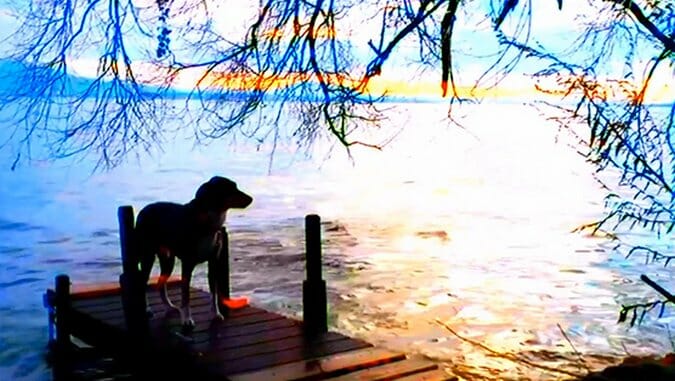Goodbye to Language

Jean-Luc Godard has made his new film, Goodbye to Language, in much the same spirit as Tar? Gomi’s seminal children’s book Everyone Poops: no matter what differences may set us apart from one another, we’re all united through our undeniable human need to defecate. It’s the greatest of equalizers.
This, of course, suggests that any such spirit can be coaxed out of the film in just one screening. Woven sporadically throughout Godard’s visual essay are moments in which his quartet of protagonists talk philosophy on the john, the thunder of their bowel-voiding peppering conversation with the sounds of intestinal exertion. Coming from any other director, these sequences might stretch our willingness to offer our continued patience, but anyone who signs on for a modern Godard flick should probably have an idea of what they’re getting into. This holds true for Goodbye to Language as much as it does for, say, 2010’s Film Socialisme or 2004’s Notre Musique—though the latter films are downright coherent by comparison.
It’s dense. It’s opaque. Goodbye to Language is crafted in a way that aggressively defies immediate understanding, really allowing only mitotic absorption; though it clocks in at 70 minutes, it feels like it’s twice as long. As a topper, Godard and his cinematographer Fabrice Aragno shot the whole damn thing in 3D. Coats, branches and many sundry objects poke out at us from the screen while the colors—oh, the colors!—practically vibrate with intrusive urgency. The toilet humor is almost a palette cleanser for his movie’s experimental qualities—which is a sentence I stand wholeheartedly behind. But these aren’t complaints; they’re the exact reason that the movie is such a joy to behold.
For those now under the impression that Goodbye to Language is nothing more than a jumble of disjointed images, there is, in fact, a plot, though the word “plot” is applied here loosely. There are two couples, Gédéon (Kamel Abdeli) and Josette (Héloïse Godet), and Marcus (Richard Chevallier) and Ivitch (Zoé Bruneau), and the film revolves around their separate, distinct interactions at irregular intervals. They talk about subjects and ideas in the abstract; chat politics; thumb through a book of Nicolas dae Staël paintings; observe violent authority in the streets; take off their clothes; take dumps—though not necessarily in this order (or any order, really, as the whole picture is edited out of chronological order). Eventually, a fifth character, a dog (Roxy, Godard’s own dog), is introduced, and questions about man’s place in nature are raised as the audience coos at the pooch’s inherent canine charisma. (For what it’s worth, Roxy is more arresting than his human co-stars only because he’s adorable.)
-

-

-

-

-

-

-

-

-

-

-

-

-

-

-

-

-

-

-

-

-

-

-

-

-

-

-

-

-

-

-

-

-

-

-

-

-

-

-

-








































